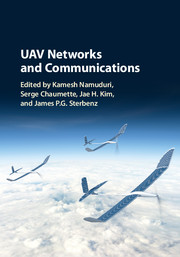Book contents
- Frontmatter
- Dedication
- Contents
- Preface
- Contributors
- 1 Introduction to UAV Systems
- 2 Air-to-Ground and Air-to-Air Data Link Communication
- 3 Aerial Wi-Fi Networks
- 4 Disruption-Tolerant Airborne Networks and Protocols
- 5 UAV Systems and Networks: Emulation and Field Demonstration
- 6 Integrating UAS into the NAS – Regulatory, Technical, and Research Challenges
- 7 Safety, Security, and Privacy Aspects in UAV Networks
- 8 Collaboration Between Autonomous Drones and Swarming
- 9 Real-World Applications
- References
- Index
5 - UAV Systems and Networks: Emulation and Field Demonstration
Published online by Cambridge University Press: 17 November 2017
- Frontmatter
- Dedication
- Contents
- Preface
- Contributors
- 1 Introduction to UAV Systems
- 2 Air-to-Ground and Air-to-Air Data Link Communication
- 3 Aerial Wi-Fi Networks
- 4 Disruption-Tolerant Airborne Networks and Protocols
- 5 UAV Systems and Networks: Emulation and Field Demonstration
- 6 Integrating UAS into the NAS – Regulatory, Technical, and Research Challenges
- 7 Safety, Security, and Privacy Aspects in UAV Networks
- 8 Collaboration Between Autonomous Drones and Swarming
- 9 Real-World Applications
- References
- Index
Summary
This chapter discusses the design, implementation and deployment of an unmanned aerial vehicle (UAV) network for the purpose of transmitting video surveillance data amongst nodes. It presents a heterogeneous network consisting of multiple stationary and mobile ground-based nodes, as well as multiple autonomous aerial vehicles. A design process to enable emergent system safety in an Unmanned Aerial Vehicle Platform System through the correct integration of critical UAV subsystems in a scalable fashion to enable collaboration across multiple UAVs is outlined. The UAV network system field demonstration comprised of 16 fixed ground nodes, 1 mobile ground node, and 2 airborne nodes connected by two routing gateways to a legacy wired network is described. Networking and communications effects, including the impact of node mobility, network partitioning and merging, as well as gateway failovers are examined through the course of the demonstration. Discussion of the networking protocols deployed, as well as analysis of performance issues are then placed in context of the overall field demonstration.
Unmanned Aerial Vehicle (UAV) Platform Systems
The Aerospace Laboratory for Embedded Autonomous Systems (ALEAS) Unmanned Aerial Vehicle (UAV) platform system consists of several individual Unmanned Aerial Vehicles (UAVs). Each system had a common architecture along with attendant ground stations which can be used to relay commands, as well as operational procedures, to the UAVs if needed. Amodular software infrastructure was then used to enable collaborative UAV flight [361]. The main purpose of the UAS platform was to develop assurance methods to enable autonomous flight of UAVs in a shared airspace environment, such as the National Airspace System (NAS). Thus, a primary concern was making sure that the system exhibits high safety and reliability standards. The field demonstration [125], further detailed in Section 5.2.1, required that a video be streamed across a network comprised of both ground and aerial nodes. As fielded in the outlined experiment, the UAS system consisted of two UAVs, continuously operating at an altitude of approximately 100–300ft. above ground level for roughly 50 minutes each.
- Type
- Chapter
- Information
- UAV Networks and Communications , pp. 96 - 119Publisher: Cambridge University PressPrint publication year: 2017

